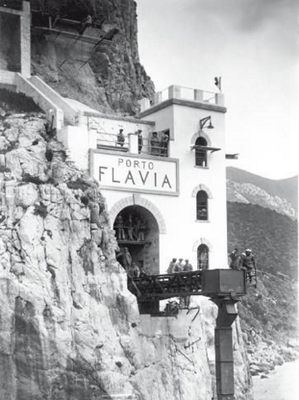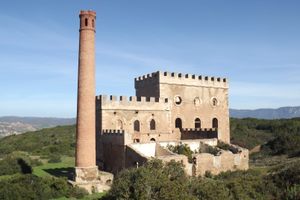About
No other port or sea harbor in the world is quite like Italy's Porto Flavia. Built in 1924, the ingenious cliff-face port allowed workers to lower ore directly down from the cliff into cargo ships waiting below.
In 1922, the Masua mining operations in Sardinia, which had been active ever since the early 1600s, had reached a peak of production. Zinc and lead were in high demand, and modernized mining methods meant that more ore was being extracted than ever before.
Efficiency, however, was becoming a serious issue. At the time, transporting the zinc and lead ore from the mines to the nearest port was a lengthy and costly process. Sailors had to come from the island harbor at Carloforte, about 15 miles to the south. Once they arrived on the beaches near Masua, they would load up their boats with ore before heading back to Carloforte.
The return journey was slow and dangerous. Weighed down by ore, the small boats often sank, especially in stormy conditions. Adverse weather could hold up the flow of ore for weeks on end, and it could take more than a month to fully load the hold of a steamship waiting in Carloforte.
In search of a solution to this problem, the owners of the mining operation turned to the Italian engineer Cesare Vecelli. Vecelli began to survey the coast near Masua, looking for a place where steamships could safely moor and be loaded close to the mines. His chosen location, a high, ragged cliff face jutting out into the sea, may have had some people scratching their heads.
But Vecelli had an ingenious plan. He proposed the construction of a port built directly into the cliff face. The cliff face would be connected to the top of the cliffs via a system of tunnels, through which the lead and zinc would be carried down. The water at his chosen location was deep enough and sheltered enough for steamships to moor below, from which they could be loaded by gravity alone.
It was a bold idea, but one which his backers decided to accept. Work began in 1923, with a team of expert miners and climbers brought in for the dangerous construction project. Using dynamite and mechanical drills, the workers managed to excavate two tunnels, one above the other, each about 2,000 feet long. And each tunnel was connected by nine vertical shafts that served as reservoirs for the ore.
A small electric train was installed in the upper tunnel, and was used to bring in the ore from above. The ore was then tipped down into the reservoirs, from where it could be unloaded onto a conveyor belt system in the lower tunnel. The conveyor belt ran down through the tunnel toward the cliff face and then extended a full 50 feet out above the water. Any cargo ship moored beneath it could be filled in a couple of days.
At the request of the mining company, Vecelli also added some purely aesthetic details, including a concrete tower, an arched doorway, and arched windows, giving the port a certain faux-historic elegance.
Remarkably, the construction of the port took less than two years. The mine owners were delighted, especially when they realized that the newly operational cliff port was reducing their production costs by about 70 percent. And in recognition of his achievement, the owners allowed Vecelli to name the port. He named it after his daughter, Flavia, who was born earlier in 1924.
Porto Flavia began to decline in the 1960s, along with the local mining industry, and was eventually closed in the 1990s. Ownership of the site then passed to IGEA SpA, a public company that specializes in the restoration and preservation of old mining plants.
Related Tags
Know Before You Go
Porto Flavia is located near Nebida in the Iglesias comune of South Sardinia, Italy. You can get there by following the road that starts at the beach of Masua. Visits are by guided tour only (some of the guides used to work at the port or nearby mines), and can be booked in advance from the tourist office in Iglesias. Guided tours start approximately every hour, but it’s best to check in advance as seasonal variations can occur. Entrance is €10 (about $11.30 US).
Flavors of Italy: Roman Carbonara, Florentine Steak & Venetian Cocktails
Savor local cuisine across Rome, Florence & Venice.
Book NowPublished
June 17, 2019































